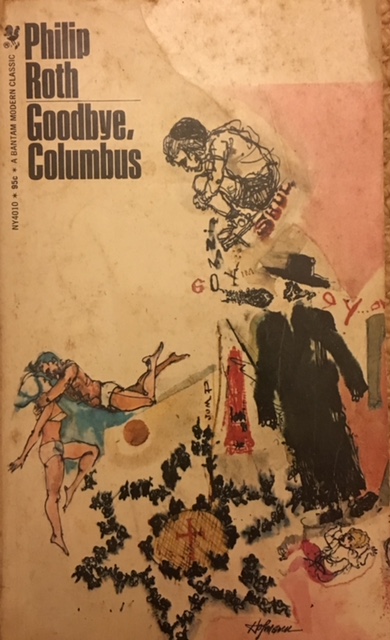I discovered Philip Roth at age 17. In retrospect, it was the ideal age for a young Jewish man growing up in the suburbs of New Jersey to discover this “pre-eminent figure [of] 20th-century literature”.
I owe Roth a great debt. He showed me that the lives of Jewish men in suburban New Jersey could embody both romance and the “larger than life” elements that make stories big and give meaning to our existence. In his first book, Goodbye Columbus, consisting of a novella plus five short stories, the lead story (“Columbus”) runs only 97 pages in the paperback edition that I have carried with me through numerous households and two countries (see image below). The story charts a doomed summer romance between Neil Klugman, a lower middle class young man who works in the Newark library, and Brenda Patimkin, an over-indulged upper middle class sculpted beauty who lives in suburban Short Hills and studies at Radcliffe College (Harvard University).
Roth wrote in 1989 for the novella’s 30th anniversary edition, that he was both “unapologetic and critically freewheeling about the class of Jews whose customs and beliefs had shaped his boyhood society,” highlighting “the mundane household dramas of his Jewish New Jersey”. Roth was thrilled and amazed:
that any truly literate audience could seriously be interested in his store of tribal secrets, in what he knew, as a child of his neighborhood, about the rites and taboos of his clan – about their aversions, their aspirations, their fears of deviance and defection, their underlying embarrassments and their ideas of success.
Although the book was published in 1959, I didn’t discover it until much later, around the same time that the movie version (1969) was released, starring Richard Benjamin as Neil and Ali McGraw at Brenda. As a long-time writer and lecturer on Jewish film, I frequently use Goodbye Columbus (the movie) as one of my best examples. Set in a totally insider Jewish environment, the film neatly captures the same feeling – the American-Jewish suburban experience – as the book, although sadly updated the action to the Bronx and Westchester from my beloved New Jersey. It does, however, present – satirically, mostly lovingly, and never less than critically – a good range of Jewish suburban characters. Two scenes stand out in my memory: Neil’s first dinner at Brenda’s house (click here for a 2’26” YouTube clip) and the infamous and frequently criticised over-the-top Jewish wedding scene (short YouTube clip here).
In my last year of high school I produced a “term paper” that analysed Roth’s first four novels: Goodbye Columbus, Letting Go, When She Was Good and Portnoy’s Complaint. The second and third novels are far from Roth’s best, and – despite widespread critical acclaim – I never warmed to “Portnoy”, which became a truly terrible film. My term paper accurately predicted that Roth would become one of America’s great modern novelists; my then English teacher disagreed. Other than our New Jersey Jewish upbringing, Roth and I shared one other salient fact: both of our fathers worked for the Metropolitan Life Insurance company, now known as MetLife.
Roth has continued to play an important role in my literary and personal life since those high school experiences – he has his own category in my writing blog – although has been far from the lodestar role he played at age 17. My favourite Roth books are his “political” novels: American Pastoral (which became an under-released film that never made it to Australia), I Married a Communist, The Human Stain (read my review of the 2004 film here) and The Plot Against America, a frightening book which has taken on unexpected new meaning in the age of Trump.
Roth also played a role, albeit indirectly, in my own romantic life choices. I was introduced to my wife some years ago by a Jewish yoga teacher from New Jersey whose father taught English to … yes, Philip Roth … at Weequahic High School in Newark, New Jersey. In more recent years, I reviewed The Humbling (2010) for the Australian Jewish News, and have closely tracked the adaptation of Roth’s books into films, most recently reviewing the film adaptation of Indignation (2016).
I am not the only person so affected by Roth’s writing. Nathaniel Rich – almost a generation younger than me – writes that:
I felt an immediate intimacy with the novel’s author, Philip Roth. Though two generations separated us, I felt that he spoke directly to me or, in some mystical, incoherent sense, spoke from somewhere inside my brain. I had read novels that frightened and delighted me, made me laugh, made me question—Roth’s writing did all that, but it also elicited a spookier response. I had never before read a writer who knew me. It was a shock to discover that others felt the same way—including many who were not Jewish teenage boys.
More on Roth
Very few authors have a whole journal devoted to their work. Philip Roth does, published by Purdue University Press since 2005. Wikipedia has produced a full bibliography of Roth’s work. The New York Times has provided a “starter kit” of what Roth novels to read – although I don’t agree with their choices: no reference to The Plot Against America – seriously? What’s fascinating is how Roth reached so many non-Jews, such as ABC Radio presenter Sarah Kanowski, interviewed about Roth’s legacy on Late Night Live in May. For more analysis of Goodbye Columbus, read Saul Bellow’s original review of the book in the July 1959 edition of Commentary, and Elaine Blair’s rethinking of the book’s ending in The Paris Review, April 2017.
 (Image above: the cover of my original copy of Goodbye Columbus, 1968 Bantam paperback edition)
(Image above: the cover of my original copy of Goodbye Columbus, 1968 Bantam paperback edition)



 Posted by donperlgut
Posted by donperlgut